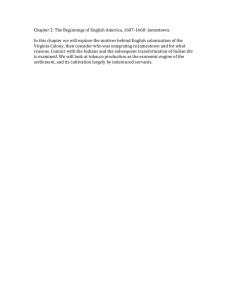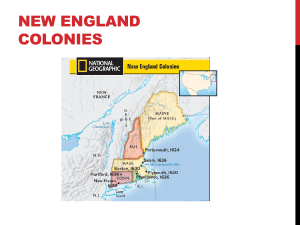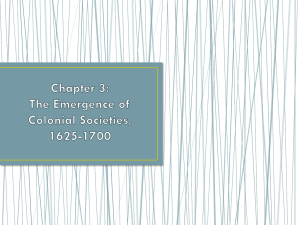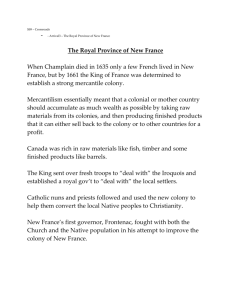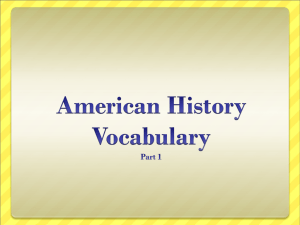Growth of Colonial America
advertisement
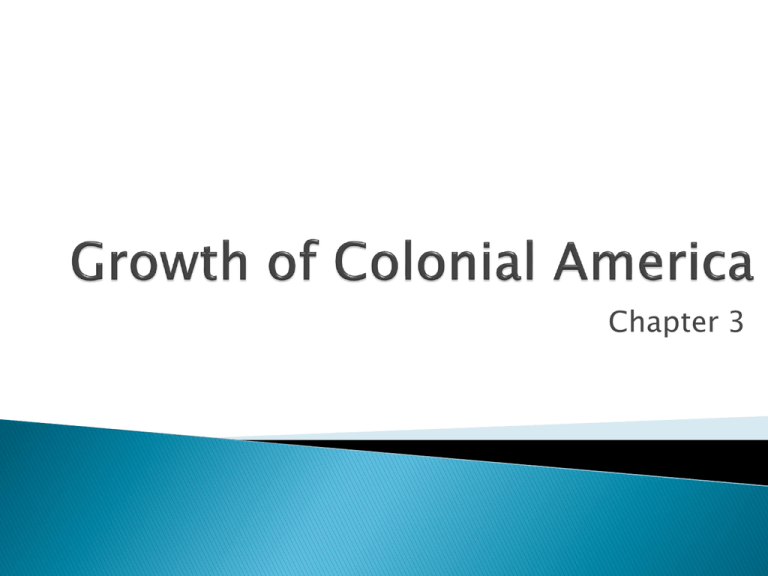
Chapter 3 Exploration and Settlement by France, Holland, and Spain ◦ Dynamics Desire for spices Break Italian monopoly Renaissance ◦ Spain Explorers Columbus, Cortes, Coronado etc. Three G’s Negative impact on natives ◦ France Explorers Overlap of settlements Peaceful coexistence ◦ Dutch Henry Hudson Colony in New York Types of Colonies ◦ Corporate Jamestown Joint-stock companies investments ◦ Royal VA 1624 Direct rule by King ◦ Proprietary MD, PA Gifts given to individuals by King Every colony has to have a CHARTER from King ◦ Aka permission 1607 Founder ◦ Virginia Company of London Purpose Type ◦ Elected assembly 1619 ◦ House of Burgesses *assembly returns for tax under Charles I 1628: bi-cameral Basic unit of government ◦ Wealth, Northwest Passage ◦ Corporate ◦ Joint-stock companies ◦ Royal Colony in 1624 Government ◦ County-court system Economy ◦ Tobacco Plantations 50 year depression Workers ◦ 1st White indentured workers 90% of population for the Chesapeake Slavery a racial status in 1670 ◦ Soon slaves Special Characteristics ◦ Followed Anglican church ◦ More men than women ◦ Later big gap between rich planters and poor farmers = bacon’s rebellion 1620 Founder ◦ Puritans ◦ Escape religious persecution Type ◦ ◦ ◦ ◦ General Court Towns send 2 delegates Town meetings Local government Plymouth: separatists MBS: puritans, “City Upon a Hill” Corporate Joint-Stock Companies Royal Colony in 1691 Government ◦ Purpose ◦ NO separation of church and state ◦ ◦ ◦ ◦ Not suited for farming Lumber, fish, furs Subsistence Vibrant merchant class Economy Local administration Determine qualifications for voting, holding office BIG problem for Puritans Workers ◦ ◦ ◦ Some indentured servants Mainly family members Few to NO slaves ◦ Dissenters- NO tolerance Characteristics ◦ Roger Williams, Anne Hutchinson, Thomas Hooker Dominated by Puritan influence Creation of Public Education Harvard – train ministers 1626 Founder ◦ Dutch ◦ Originally called New Netherland Government Economy ◦ ◦ ◦ ◦ Purpose ◦ Trade New Type ◦ For Dutch: Jointstock companies (Dutch West India Company) ◦ 1664- Taken by English “bloodless battle” King wants new way to raise revenue through rent and taxes ◦ Royal Colony 1685 ◦ Continually changed Trade Small-scale industry Some agriculture Vibrant merchant class Sets up future issues with mercantilism Workers Characteristics ◦ Indentured servants ◦ Families ◦ Few slaves ◦ First multi-ethnic colony 8 languages spoken ◦ New Amsterdam (NYC) becomes major trading port ◦ Influence of Swedish introduces log cabin 1633 Founder ◦ Cecil Calvert Aka Lord Baltimore Purpose ◦ Catholic haven ◦ Assembly (Royal influence) Economy ◦ Tobacco Workers ◦ Indentured servants ◦ Slaves Type ◦ Proprietary ◦ 1st one awarded ◦ NEVER becomes Royal Colony Government Slavery recognized in as a status in 1661 Special Characteristics ◦ Religious issues ◦ More Protestant farmers that Catholic planters ◦ Act of religious toleration 1649 Government Economy ◦ Roger Williams Workers ◦ Persecuted by MBC for belief in separation of church and state Characteristics 1636 Founder Purpose Type ◦ Proprietary charter given in 1664 ◦ NEVER becomes Royal Colony ◦ Royal influenced ◦ Usually independent ◦ Agriculture dominant ◦ Small farms ◦ Modest in scope ◦ Indentured servants ◦ Families ◦ Few slaves ◦ Wanted religious freedom and tolerance 1636 Founder ◦ Wrote 1st constitution in History (1639) ◦ Representative government with legislature ◦ Rev. Thomas Hooker Purpose ◦ Religious toleration ◦ Left Mass. Type ◦ Proprietary Charter 1662 ◦ NEVER becomes Royal colony Government Popular vote Governor chosen by legislature Economy ◦ Self-sufficient ◦ Agriculture/ fishing Workers ◦ farmers Characteristics ◦ Future site of Pequot War 1638 Founder Purpose Type ◦ 1702 granted from William Penn Government Economy Workers Characteristics ◦ Peter Minut ◦ New Sweden ◦ Support Swedish trade ◦ Proprietary Became part of New York with “bloodless battle” against Dutch ◦ Granted to William Penn in 1681 as part of his Proprietary ◦ NEVER a Royal colony ◦ Penn had a very hard time governing Delaware because the economy and geology was largely the same as that of the Chesapeake. He attempted to merge the governments of Pennsylvania and the lower counties of Delaware. Representatives from both areas clashed heavily and in 1701 Penn agreed in having two separate assemblies. ◦ trade ◦ Traders ◦ Indentured servants ◦ Delaware, like Philadelphia and unlike Maryland, continued to be a melting pot of sorts and was home to Swedes, Finns, Dutch, French, in addition to the English who constituted the dominant culture. Government 1638 Founder Purpose Economy Workers Characteristics ◦ John Wheelwright ◦ People from Hampshire, England ◦ Profit from fisheries Type ◦ Proprietary first ◦ Royal 1668 Created by King to take control away from Mass. ◦ Royal Colony 1679 ◦ Early period: lack of government ◦ Protected by MBC ◦ Fishing, lumber ◦ Self-sufficient ◦ Pretty boring 1653 Government Economy ◦ Proprietary ◦ Land given to 8 nobles Workers ◦ Royal Colony 1729 Characteristics ◦ Carolina’s divided in 1712 Founder Purpose Type ◦ Proprietors ◦ Sell land, make profit Included South Carolina ◦ King appointed Governor ◦ ◦ ◦ ◦ Tobacco, Rice, Indigo Some plantations More self-sufficient farms *compatible with Mercantilism ◦ Indentured servants ◦ Some slaves ◦ More self-sufficient farms than S. Carolina ◦ Followed Anglican church 1663 Founder ◦ Part of Carolina 8 Nobles Purpose Government Economy ◦ Rice, Indigo Plantations dominate ◦ To make profit through trade and selling land Type ◦ King appointed Governor ◦ *works well with mercantilism ◦ Proprietary ◦ Royal Colony 1729 Workers ◦ Native first ◦ Slaves By 1750 = 61% of population Characteristics ◦ Develops Rice crop Leads to massive increase in Slavery ◦ Followed Anglican church ◦ Lots of interaction with natives Yamessee Queen Anne’s War Government ◦ Proprietor appt. Governor 1st ◦ King appointed Governor ◦ trade Settled 1610s Founder Purpose Type ◦ Proprietary ◦ proprietary colony in 1664 ◦ Royal colony in 1702 Workers ◦ Indentured servants ◦ Self-sufficient ◦ traders ◦ Lord Berkeley ◦ Dutch settlers ◦ Part of New Netherlands Economy Characteristics ◦ To attract settlers promised religious freedom 1682 Founder ◦ William Penn Purpose Type Government Economy ◦ ◦ ◦ ◦ ◦ “Holy Experiment” ◦ Quakers ◦ Proprietary ◦ NEVER a Royal Colony ◦ King appointed Governor Some small-scale industry agriculture Trade centers Vibrant merchant class *not compatible with mercantilism Workers Characteristics ◦ Indentured servants ◦ Families ◦ Few to NO slaves ◦ Haven for Quakers (Society of Friends) ◦ Committed to non-violence and social justice ◦ Good relations with natives ◦ Philadelphia “city of brotherly love” Cultural center 1732 Founder Purpose Type ◦ James Oglethorpe ◦ Help people avoid English debtor’s prisons ◦ Haven for Protestants ◦ Royal Charter ◦ Royal Colony in 1752 Government Economy Workers Characteristics ◦ Royal appt. governor ◦ Eventually plantations ◦ Indentured workers ◦ Slaves (eventually) ◦ Felons ◦ Oglethorpe had strict rules like no alcohol ◦ Allowed only to be a buffer state and free over-crowded prisons

